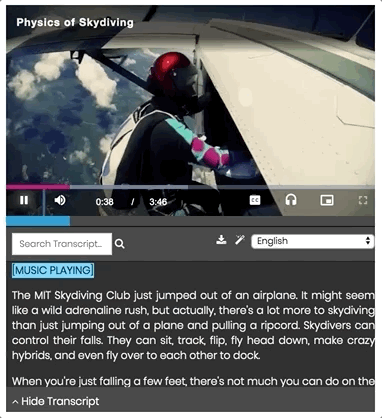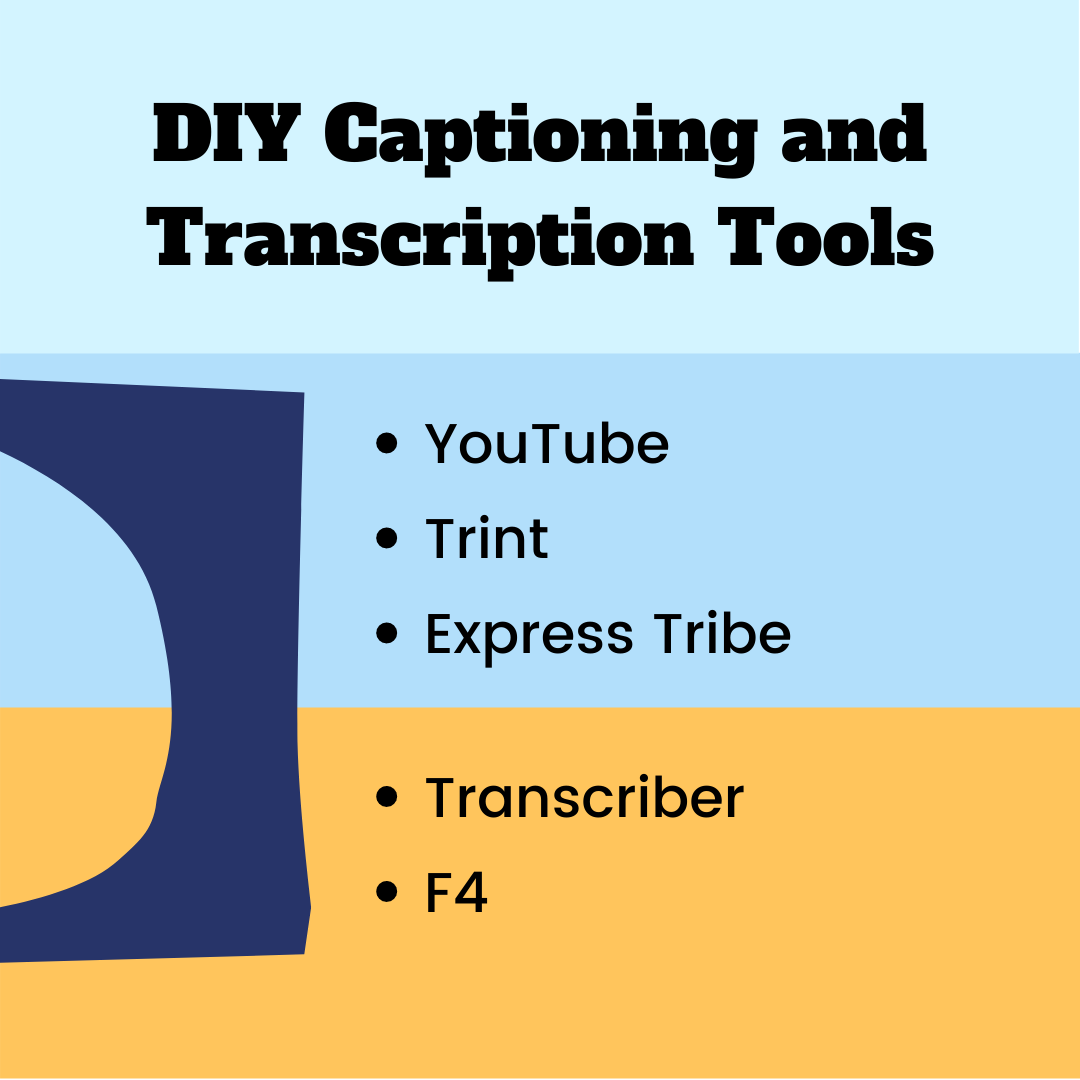Table of Contents
From video terminology to how to boost video SEO, this guide will teach you everything you need to know about video SEO.
What is Video SEO?

Search engine optimization (SEO) is the practice of boosting the quality and quantity of traffic to your website by optimizing pages for organic search engine results. Many factors are taken into consideration when determining the ranking of your websites, like the quality of links to your site and content length. So, what is video SEO? For video content, ranking factors include page load speed and video quality. Although content like blog posts and web pages differ from video content, video SEO serves the same purpose: it aims to increase the searchability of your videos.
With video SEO, however, there’s a twist. Search engine bots crawl and index the web’s content by reading the text, so how do they rank your videos if they can’t watch them?
Video SEO
Video SEO aims to increase the searchability of videos by optimizing certain elements for search engines, such as the metadata and the quality of content.
How to Boost Video SEO with Transcripts
Transcription is the process of converting the spoken content in video and audio files into text. Since search engines are not able to watch your videos as a person would, a transcript helps to boost video SEO because it associates text with the video. When a transcript is used on-page or inserted into the metadata, search engines can read the contents of the video to gain an understanding of its message.
In addition to allowing search engines to “watch” your videos, transcripts offer additional video SEO benefits:
- Improves searchability
- Exposes keywords
- Inspires derivative content
How to Boost Video SEO with Captions
Closed captioning is a process that takes audio transcripts and synchronizes small chunks of the text to match the audio within a video. Captions come in the form of a text file that the video references as it plays allowing search engine bots to “watch” the video, i.e., read the text from the caption file.
Captions play a significant role in user experience thus improving video SEO. In fact, a Facebook study revealed that captioned videos get 12% more views than their uncaptioned counterparts.
While captions make your videos accessible to Deaf and hard of hearing individuals, they also improve the experience for everyone. Captions are beneficiary to all because they allow people to watch a video in sound sensitive environments and to grasp the content more easily. Overall, the user experience is improved which has a direct positive influence on video SEO.
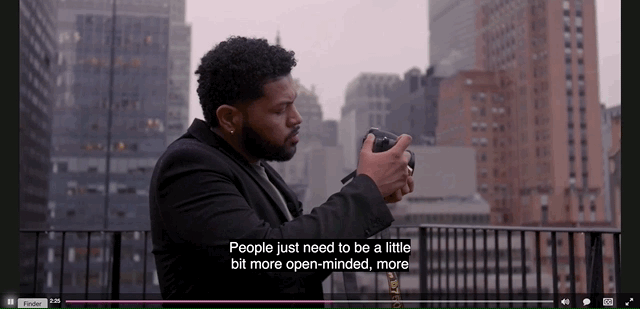
Improve the User Experience
The first rule in video SEO is that people must be prioritized over bots. Search engines measure factors based on what human beings look for in their search experience including ease of use, clarity of the message, and quality and credibility of the content. Every video should display the previously listed characteristics to deliver a top-notch user experience.
A simple way to improve video user experience is to always include accurate captions, transcripts, or both along with your video. To obtain captions and transcripts, you could use a professional service or create them in-house on your own. If you decide to utilize automatic speech recognition, be sure to comb through the generated transcript, conduct a quality review, and edit any errors along the way. Inaccurate captions don’t meet Google’s standards for quality, in fact, they could get a video marked as “pure spam” for displaying “automatically generated gibberish,” which could seriously hurt your video’s search rankings.
Utilize SEO Embed
An SEO Embed uses linked data to communicate to bots that your web page is hosting a video, and includes essential metadata like the video transcript. It can help boost SEO, drive more traffic to your videos, and is particularly helpful for those who host videos on their own website. With the SEO Embed, transcripts are posted to the head of the page allowing it to remain “behind the scenes” so as not to disrupt the flow of the page. Additionally, the SEO Embed inadvertently increases page load speed since the transcript is published on the backend.
Why Video Marketing Matters

Users want their search queries to be answered at lightning speeds, but with all the data out there, it’s becoming more difficult to be seen amidst all of the other content. The world wants content that’s unique, engaging, and easily comprehensible. That’s why video marketing is rising in popularity.
There are more than 5 billion internet searches conducted worldwide on a daily basis, with Google processing 44,000 searches every second. More video content is uploaded to the web in one month than TV has created in three decades. By 2019, 80% of the world’s internet traffic will be video.
Videos can have a powerful impact on your audience, but in order to leave a lasting impression, they must first be seen. That’s where video SEO comes in, and why you should implement video SEO boosting tactics like captioning and transcription into your video marketing strategy.
Social Media Marketing and Video SEO
There’s much that goes into social media marketing and it takes a great deal of planning and organization to see positive results for your business. Among the many types of content shared on social media platforms, how does video stack up?
Highlighted in a Tubular Insights article, Mark Zuckerberg, CEO of Facebook, announced that “Video is an important part of the Facebook experience.” In fact, a 2015 Facebook report indicated that over 500 million people watch videos on their platform daily, totaling 100 million hours of video each day. This video boom doesn’t just apply to Facebook either, it applies to all popular networking sites like Instagram and Twitter.
How to Boost Video SEO with Social Media
Strategically sharing your video content on social media channels can increase inbound links, website traffic, click-through-rate, and the time spent on your site, all of which can significantly improve your video rank in search results.
How Do Social Media Marketing and SEO Connect?
It’s no secret that social media marketing can improve brand recognition and increase traffic to your website. Utilizing social video can significantly ramp up engagement and user experience. The big question, however, is does social media marketing have an effect on search rankings for videos and other content?
The current answer to this question is answered by Google Webmaster Trends Analyst, Gary Illyes, who revealed that Google officially does not take social media into account for search rankings for any type of content. That’s not to say that there’s no connection between strong performance on social networks and high rankings in Google SERPs. This particular connection doesn’t necessarily mean causation, but social media marketing and video SEO can still have a positive relationship.
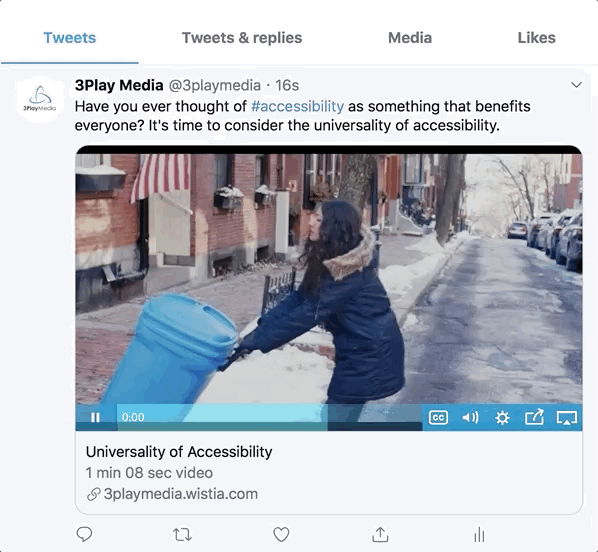
How to Boost SEO with Social Media Marketing
There are several influential search ranking factors for Google, like inbound links to your site, website traffic, click-through-rate, and time-on-site which can be greatly influenced by social media. It’s one thing to know this connection exists, it’s another thing to move your social accounts towards becoming a shareworthy source. There are several things to consider when creating video content, and it’s important to double-check that your content meets a certain standard before sharing it on any of your social accounts:
- Provides direct, actionable information relevant to common queries
- Is professionally designed and accessible to modern browsers
- Delivers high quality, legitimate, and credible content
Most importantly, sharing high-quality video content will help to grow your following and may encourage viewers to visit your site for more content – keeping them on page longer. These two factors highly affect search engine rankings, and if you play your cards right they will move in the right direction.
Online Video
There are some primary captioning considerations to make for those using online video in their marketing programs. If you’re publishing online video, things like SEO, views, engagement, workflow optimization, and accessibility compliance should matter to you since they help towards the success of your videos. The good news is that captioning and transcription is a tried and true way to improve all of those things.
When looking for a captioning vendor, you’ll want to keep cost and services in mind. You might look for things like video player integrations, which would allow you to create a seamless captioning workflow between your current video player and your caption provider. You may also search for a vendor that has unique plugins, like an SEO embed, interactive transcripts, and playlist search, all of which can directly improve video SEO by boosting engagement and searchability.
What Is YouTube SEO?

You’ve heard of SEO and have learned a little more about video SEO, so what’s the deal with YouTube SEO?
YouTube SEO is a specific type of video SEO; it involves optimizing your channel, playlists, metadata, description, and the videos themselves. Depending on your video marketing strategy, you can optimize your videos both in and outside of YouTube.
Why does YouTube SEO matter? It’s simple: YouTube is a video search powerhouse and is the second-largest search engine in the world next to Google, its parent company. Nearly 500 hours of video are uploaded every minute, and eight out of ten video search results are YouTube videos.
Getting seen in a sea of videos is challenging for anyone, and that’s why optimizing for YouTube SEO can help your videos stand out. Strategizing and planning ahead of time will pay off and get your video ranked higher in YouTube’s search engine results pages (SERP).
YouTube SEO
YouTube SEO is its own kind of video SEO which involves optimizing your channel, playlists, metadata, description, and the videos themselves to rank higher in search results.
How Does YouTube Rank Videos?
YouTube SEO is similar to video SEO, and in general, your YouTube video strategy must follow the rules of traditional SEO.
Overall, YouTube ranks videos based on two things: video content and user engagement.
Video Content
When optimizing your videos, the text should be top of mind. Types of text that are more obviously associated with videos are keywords, titles, descriptions, and tags. What may be less obvious is that transcripts and closed caption files can improve YouTube SEO substantially by increasing watch time, user engagement, and viewership.
Don’t underestimate the power of text. Bots can’t watch videos; therefore they rely on text data to index information. A key component in an impeccable YouTube SEO strategy is to take advantage of text in the form of transcripts, closed captions, and subtitles.
User Engagement
User engagement is a critical part of YouTube SEO, and bots measure how happy viewers are with your video content through several measurements, including watch time and session watch time.
These measurements indicate whether viewers are having a positive or negative user experience and may directly affect your search ranking in YouTube and on Google.
Watch Time
Watch time is the actual time viewers spend watching a video. In this case, the length of the video does matter. For example, 50% completion of a 10-minute-video will still rank higher than 100% completion of a 3-minute-video (i.e., a five minute watch time exceeds a three minute watch time.)
The goal is to get viewers watching your videos for longer. To grab their attention early, start your videos with a 15-second clip that’s sure to pique their interest.
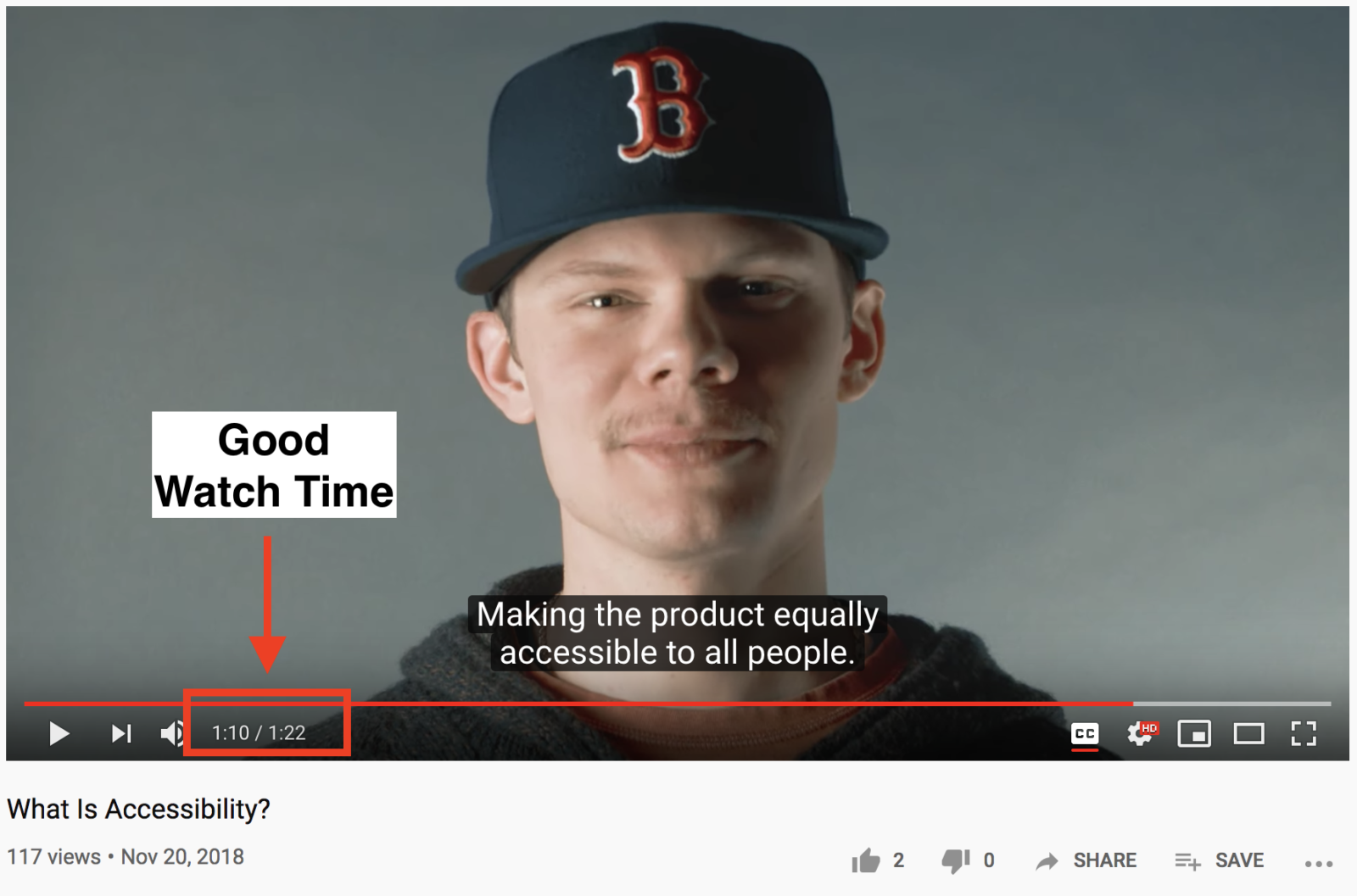
Session Watch Time
Session watch time refers to how long a viewer stays on YouTube’s website after viewing your video, the purpose of which is to measure the value of the video to the overall viewer’s session. YouTube favors videos that keep people on-site for a longer time, and there are ways to encourage your viewers to do so. First, avoid using YouTube videos that direct people to another website since that will cause them to end their session time. You can also utilize video playlists which allow you to group complementing videos together.
How to Rank on YouTube
Ditch YouTube’s Automatic Captions
Did you know that YouTube captions are only 70% accurate? That’s bad for two reasons: it’s not accessible, and it’s detrimental to search rankings. Automatic captions often produce “automatically generated gibberish” which can get your video marked as spam and knock your ranking way down.
On the other hand, accurate captions can be very beneficial for YouTube SEO and taking the time to correct your caption files is well worth it. To obtain accurate captions you could manually clean up the automatic transcript generated by YouTube, but that’s time-consuming. The best solution is to seek a professional service that guarantees transcript and caption accuracy.
Include Transcripts
Transcripts, similar to closed captions, are a great way to improve video SEO of any kind. For YouTube SEO specifically, there are several things you can do with a transcript:
First, make sure your transcripts are keyword optimized. This is accomplished by audibly saying focus keywords throughout your videos. Next, transcribe your content and put it into the video description box for bots to crawl. If the transcript is too long, you can always link to an off-page transcript. Finally, scan transcripts for derivative content ideas. You will find that transcripts are a great starting point for creating new content such as blogs, infographics, and white papers.
Add Language Translation
Chances are that when you’re creating video content, your goal is to reach a bigger audience, not a smaller one. One way to expand your potential reach is to translate your video transcripts into other languages. Not only is this your chance to go global, but it’s another opportunity to grow your YouTube SEO. Did you know that search engines rank content separately for different languages? This is your chance to rise in SERPs and appeal to a global audience.
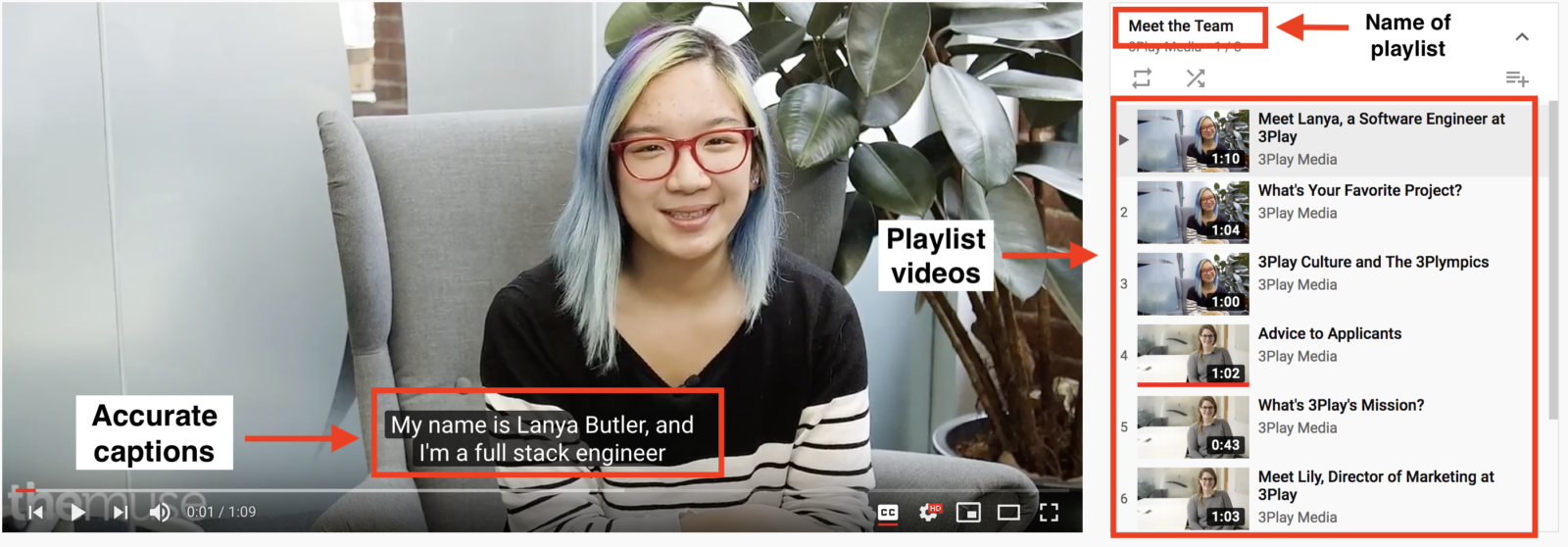
Use Video Playlists
A video playlist can boost video SEO on your website by yielding higher engagement and better user experience. YouTube video playlist can help your YouTube SEO much in the same way.
A short, subcategorized playlist encourages users to continue their viewing session after one video, thus increasing session watch time. The key is to make the videos within a playlist relevant to each other so that’s it’s a better overall viewing experience for users.
What Is Video Search?
With such large video libraries, how do you organize and simplify the experience for viewers to find the information they need? The solution is video search.
There are two things to look at when it comes to video search: finding the video you’re looking for and finding the part within a video that you’re looking for. At this point, most videos aren’t searchable. Although you can search for a video on Google or YouTube, there’s usually no option to search within the video. It’s time to change that.
Making videos searchable makes them more interactive, improves video SEO, and simplifies the process of finding keywords.
What are searchable videos?
Searchable vidoes does not refer to finding the video you’re looking for in search engines. It instead refers to finding a specific location within a video that you’re currently watching. Video searchability is typically not an available functionality for most videos. However, interactive transcripts makes the video itself searchable for the user.
Interactive Transcript
According to Digital Information World, 55% of people watch videos online every day. With so many people tuning in to online video, how can organizations create a better user experience for their viewers?
An interactive transcript is a time-synchronized transcript that highlights the words as they are being spoken in a video and is an excellent solution for making videos searchable.
How does it work, though? A transcript is connected to a video, and the transcript and video work together to create an interactive experience. The interactive transcript lets viewers search within the video; when they type a word in the search bar, it highlights each instance it appears in the transcript. Clicking on any one of those instances prompts the video to jump to that specific time.
Benefits of Interactive Transcripts
On top of interactive transcripts ability to make video search possible, there are a plethora of benefits that immensely improve the user experience.
For instance, interactive transcripts help students by allowing them to search for essential terms and topics within videos. In a case study conducted by MIT’s OpenCourseWare, results showed that 95% of students were able to find the desired content. Having an interactive transcript makes it easier than ever to search for specific information in a video.
Interactive transcripts also facilitate better comprehension for viewers since they deliver content to viewers in multiple ways at once. Viewers can choose to follow along with the time-synchronized transcript while they listen to the video or turn on the closed captions feature. If they feel they missed out on pertinent information, they can search the transcript navigation bar for specific video content. A user also has the option to use all interactive transcript features at once.
Interactive transcripts allow viewers to tailor their own viewing experience and to engage with video content in a way that works best for their individual preferences.
Best Practices for Interactive Transcripts
As with closed captions and standard transcripts, interactive transcripts require you to follow some best practices. Adhering to the following best practices will ensure that viewers get the most out of their video viewing experience:
Interactive transcripts must meet the FCC’s guidelines for accuracy and synchronization, and they should provide accurate grammar and punctuation. Transcripts should be verbatim if possible and include speaker labels and non-speech sound.
Video Engagement

Video search and interactive transcripts have everything to do with providing engaging videos. User engagement is one of the most important aspects of video content; engaging videos keep viewers coming back for more.
How do you improve your video engagement? For starters, let’s take a little inventory of YouTube metrics that matter and how to improve your videos’ numbers:
Metrics That Matter
- Views
Views are the number of times a video has been viewed. This number is located just below the video itself. To increase your video views, make sure you share engaging and accessible content and use eye-catching thumbnail images.
- Sessions
This metric determines how a video contributes to the overall viewing session. The idea is to keep visitors on YouTube’s platform for as long as possible. In your videos or descriptions, don’t encourage viewers to traverse to other sites even if it is your own. Keep them wanting more by creating playlists that group relevant and enticing videos together
- Watch Time
Watch time is the amount of time a viewer spends watching a video. Keep people watching your videos longer by hooking them right away, at least within the first 15 seconds. Be sure to state the purpose and the value that the video provides in the beginning, as well.
What Makes a Video Engaging?
We’ve discussed how YouTube measures video engagement, but how do you determine engagement for videos hosted on other video platforms or directly on your website?
- Searchability
When it comes to search queries, search engines are now tailoring results to take user intent into consideration rather than exact keywords. Videos that are relevant to the search query will appear in SERPs based on a user’s past behavior. If a person has previously selected a result that led to one of your videos and then almost immediately backed out, that means your searchability is lacking. Check your bounce rate, if it’s high you’ll want to consider rethinking your video SEO practices to get your videos in front of the right people.
- Captions and Transcripts
The answer to increasing your videos’ searchability and making them more engaging is to add captions and transcripts to the videos in your library. This is the first step to making your videos searchable, but captions and transcripts provide an abundance of benefits beyond video navigation. By including captions, your videos instantly become more captivating and accessible to a broader audience. If you add captions, be sure to do it correctly: conduct quality checks for accuracy, ensure caption files are correctly synced with videos, and always include speaker identifications.
Benefits of Engaging Videos
One of the most influential factors in search engine optimization is user engagement. Search engines want to see that people are flocking to your videos organically and that they are staying to watch the whole thing. This comes down to video engagement. Are your videos interesting? Are they delivering valuable content? As noted above, there are many ways to test your video engagement, but there’s one thing you should always remember when creating video content:
Always optimize for humans, not for search engine bots. At the end of the day, it’s people who need to see the value in your content.
The Best Video SEO Tools
The following tools work to enhance the three things that search engines care most about: user experience (UX), keywords, and metadata.
User Experience Tools
User experience (UX) is how a person reacts when using a product, service, or system. The better the UX, the longer people are likely to stay on the page, which is excellent for video SEO. Organizational and visual design tools will assist you in making quality content that maintains the interest of viewers.
Organization
There aren’t any SEO tools that are going to tell you which videos to create. Several tools are available to help you, though. With these tools, you’ll stay organized and be prepared to produce high-quality content that delivers value to viewers.
- Airtable is an organizational platform that has a digital video production template that allows you to plan your videos from pre- to post-production.
- Trello has fully customizable workflow options, keeps your video ideas in one place, and allows you to easily collaborate with team members to make your video content a reality.
Visual Design
Don’t overlook the visual elements when it comes to video, for it can have an impact on video SEO. How? For example, video thumbnails can either entice people to click on your videos or not. The thumbnail images are also used for rich snippets in search engine results, and when designed well, can increase the click-through rate.
Canva, a freemium design software, is easy-to-use and allows you to create eye-catching visuals in no time. It takes just moments to add text or design elements over images, and you can download in multiple sizes and formats. Remember to choose images that are relevant to the video topic and focus keyword.
You can find high-quality, royalty-free imagery on these sites:
Keyword Tools
With a little bit of planning and some helpful SEO tools, your keyword strategy will improve your videos’ search rankings.
Select the Right Keywords
Before even thinking of picking a keyword for a video, you must determine a topic you wish to cover and question that the content will aim to answer. This ensures that your videos are providing value to viewers. Once you’ve completed this step, it’s on to the next one.
Selecting the best keyword is easier said than done, but there are plenty of tools that can help.
Watch Out for Keyword Density
When it comes to keywords, it’s all about balance. You want to make sure you’re evenly sprinkling the keyword throughout the content. At the same time, overusing keywords make search engines think you’re trying too hard to rank highly. The optimal keyword density is somewhere between 0.5 and 2.5 percent.
If numbers aren’t your thing, that’s cool. This keyword density checker does the work for you and ensures you’ve got the right keyword balance.
Metadata Tools
Structured Data
Metadata can be specifically structured to enhance video SEO. Structured data, in an SEO context, “refers to implementing some type of markup on a webpage, in order to provide additional detail around the page’s content.” It can even land your video a featured snippet in search results.
This structured data guide for videos is a great place to start, and you can always check to see if you’re on the right track with Google’s Structured Data Testing tool.
SEO Embed
3Play Media’s SEO Embed uses linked data to communicate to bots that your web page is hosting a video. You can also communicate other data like the video’s title and transcript. Most importantly, the SEO Embed boosts video SEO without disrupting the look of the page.
Captioning and Transcription Tools
From a video transcript, keywords can be easily identified and therefore optimized. Captions improve focus, comprehension, and keep viewers more engaged. Finally, caption files and transcripts can be included in the metadata of a video, which allows search engine bots to read, index, and accurately rank videos in search results.
We recommend that you caption every video for accessibility reasons, but how do you get started?
It’s possible to caption and transcribe videos on your own, though it is time-consuming. If you have high volumes of video content that need captioning, it may be best to look into a professional captioning service.
DIY Captions and Transcripts
If you’ve decided to caption on your own before looking into using a vendor, we’ve got some tools that will help make the process a bit easier.
There are transcription tools available on the web that are either free or inexpensive, the most familiar free option being YouTube. Just be careful since many of the low-cost tools can create highly inaccurate transcripts. If you’re using the do-it-yourself method, don’t forget to conduct a quality review and to edit any errors that you find.
Once you transcribe the content, you’ll need to synchronize the text with the video to create captions. There’s a handful of tools that can assist you in this process.
- YouTube
- Subtitle Workshop (Windows only)
Now that you’re well-versed in the world of video SEO, it’s time to do some more exploring. Curious to learn more about video accessibility, closed captioning, and audio description? We’ve got you covered. Maybe you have more questions about how captions and transcripts affect video SEO. You don’t have to venture far to get answers. The following resources will help you to expand your knowledge of video accessibility and apply it to what you do.



















